Principal Investigator: Milind V. Khire, Syed Hashsham, Tom Voice
Funding Agency: National Science Foundation
Abstract
When Environmental Protection Agency’s (EPA) Resource Conservation and Recovery Act (RCRA) regulations came into effect in the late 80’s, the requirement of including a geomembrane (1 to 1.5 mm thick plastic sheet) in the final cap of municipal solid waste (MSW) landfills had a primary purpose of restricting infiltration into landfill to reduce leachate production and reduce gas emissions and minimize related environmental impacts. However, research data published during the last few years suggests that controlled addition of moisture to a landfill can be environmentally and economically beneficial. However, the impact of inclusion or exclusion of geomembrane in the final cap on gas emissions has not been evaluated. In order for environmental regulators to permit a final cap without a geomembrane, air quality impacts from gas emission must be evaluated. We propose to use flux chambers, a state-of-the-art device, to measure gas emissions from a bioreactor landfill cell. Exclusion of geomembrane from the final cap could potentially save landfill owners (and hence the broader population) over $1 billion in landfill capping costs over the next few decades.
The proposed research will fill in a key data gap related to quantification of landfill gas emissions from the final caps of MSW landfills operated as bioreactors. The final cap of an existing field-scale landfill bioreactor cell located in Michigan will be instrumented with: (1) gas probes to measure inorganic gas concentrations and pressure profile; and (2) flux chamber to measure inorganic and organic gas emissions from the surface. These gas emissions will be measured through a final cap containing geomembrane. The gas emissions will be measured to evaluate these three scenarios of the cap: (1) 1 cm2 hole made in the geomembrane; (2) relatively large size window cut in the geomembrane to simulate an earthen cap of clay; and (3) an earthen cap of sand. The bioreactor cell has been instrumented below the final cap as part of an ongoing research project.
The gas emissions data collected in this project will be comprehensive and unique due to the extent of the instrumentation already installed in the field-scale (~1 acre) bioreactor cell. Such comprehensive dataset will allow us to test gas generation and gas emission models requiring comprehensive physical, chemical, and biological input.


